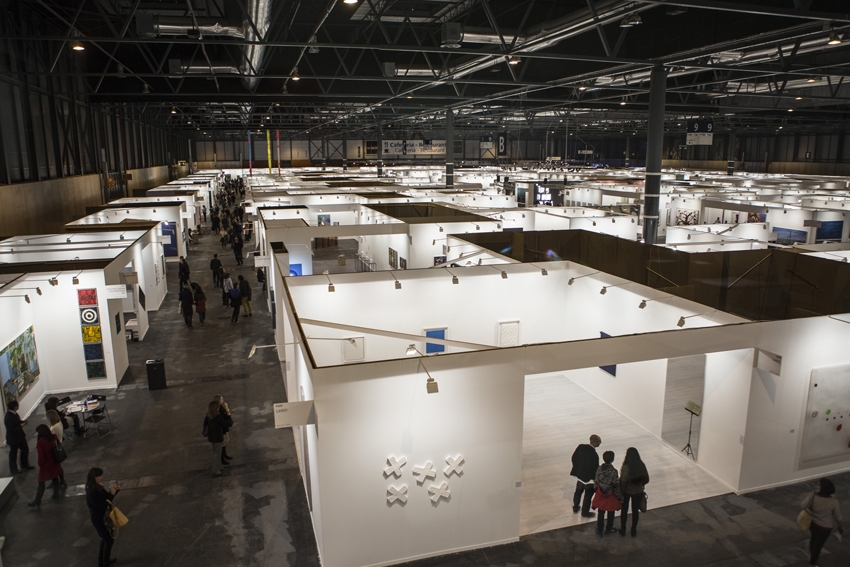In recent years ARCO has become something of a slumbering giant – slumbering because the Spanish economy was a car-crash, a giant because the 200-plus booth fair sprawls over two halls in one of those large European purpose-built exhibition hall complexes. Turn into the wrong hall (as I did) and you could find yourself in a trade show for DIY equipment. In ARCO itself, there were not many stands that could have been mistaken for DIY displays as dealers opted to play it safe with conventional hangs featuring few installation or film works. This was particularly true of the first cavernous hall, a series of elegant yet unexciting booths of mid-size European galleries who seemed to be doing reasonable business. The more interesting stuff was at the back of this hall and through into the second hall.

Instituto de Visión, installation view at ARCO 2015, showing Carlos Motta, Seis Actos: Un experimento de Justicia Narrativa, 2010, (right). Courtesy ARCO
There it was possible to find exceptions to the six paintings-two-sculptures-one nice-desk-three-discrete-chairs hang, such as the elegant and melancholic six screen installation Seis Actos: Un experimento de Justicia Narrativa (2010) by Carlos Motta that was shown by Colombian gallery Instituto de Visión. Each screen showed an actor reciting a speech by Colombian politicians who have all been assassinated for their beliefs. Filmed in the public spaces of Bogota during the presidential election of 2010, the passionate recitals of each speech took place against the laconic looks of passers-by, each actor’s exhortation of peace as the only solution to Colombia’s social and political problems met with indifference and boredom. Instituto de Visión was part of a special selection of Colombian galleries, although ARCO’s commitment to Central and South American art was embedded solidly throughout the fair and provided a more reflective focus on that set of scenes than Art Basel Miami Beach’s heady lucre-driven embrace of it.

Ramiro Chaves, XXXXXXXXXX (2014) installation view at Yautepec Gallery, ARCO 2015. Courtesy Yautepec
Mexico City-based gallery Yautepec presented a solo booth of the Argentinian artist Ramiro Chaves, who took the idea that the ‘X’ in Mexico is a symbol of its self-determination through a creolised modernity and ran with it, in a series of inkjet prints called XXXXXXXXXX (2014). The ‘x’-ifcation of Mexico’s name (from the Spanish colony Mejico) was used by architects and designers throughout the twentieth century and Chavez’s prints featured architectural, typographic, sculptural and illustrative references to the letter in Mexican visual culture. There was a nice visual echo between Yautepec’s booth and Arcade’s presentation, nearby, of Anna Barham’s series of relief prints of letters in an angular font based on a Chinese game of shifting geometric units called Tangram that became popular in Europe during the nineteenth century, titled A Step Into Tangram Rule (2010).

Constant Dullaart, Jennifer in Paradise (2013 –). Courtesy Future Gallery, Berlin
Constant Dullaart’s work at Future Gallery offered a frisson of post-internet that was curiously missing through the rest of the fair. Dullaart’s works, from the series Jennifer in paradise (2013 –) were variations of a photograph taken by the co-creator of Photoshop, Thomas Knoll, that feature an image of the back view of Knoll’s then girlfriend (later wife) sitting on a beach. This was the photo that Knoll first used to demonstrate the versatility of his new software to developers and presumably backers, demonstrating how his wife could be ‘Photoshopped’ around the beach. Dullaart’s works reference common Photoshop effects without using the software package itself. Instead the seeming doctoring of the image comes from the blurry surface of the works themselves.
Most of these booths at the fringes of the fair’s second hall were where curators lingered on their way to mysterious behind-doors, curators-only round-tables. These whispered about panels were a source of frustration and excitement to the dealers who were happy to hear that curators were milling around, but weirdly frustrated that they were locked out of their discussions, as if dealers really wanted to hear why art fairs have something to do with Deleuze and Guattrai (it was good to see Glasgow International director Sarah McCrory possibly looking as baffled by this as anyone on her way to speaking about it).

Barro Arte Contemporaneo, installation view showing Martin Legón’, Soundtrack para los 48 tomos de la colección Globus, (right) at ARCO 2015. Photo: Descubrir El Arte
Meanwhile in the other hall collectors were ponderously acquiring Julian Opie works and Katherine Grosse paintings, the type of well-to-do European connoisseurs doing the things expected of them that was subtly mocked by Martin Legón’s Soundtrack para los 48 tomos de la colección Globus, (2011) at Barro Arte Contemporaneo. The installation consisted of all of the books that make up the once popular Globus art history collection – lightweight coffee table volumes popular across Spain and Latin America. The work presented the books attached to the wall in a grid, spines facing outwards, each with a cassette tape of songs that Legón thinks are appropriate to the artist who is the subject of each book (inaudible to the viewer), perched on it. Modernism reduced to a pleasant introductory book that would look nice perched on the end of a Le Corbusier glass dining table. And a few songs that might accompany a quick perusal. Forget Deleuze and Guattari, that’s what the curators should have been thinking about.
Online exclusive published 24 March 2015
